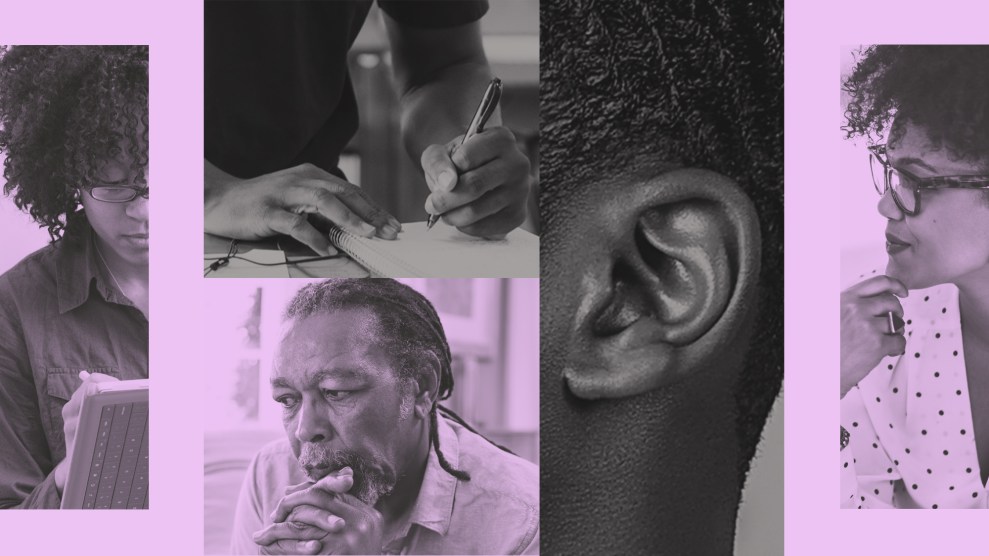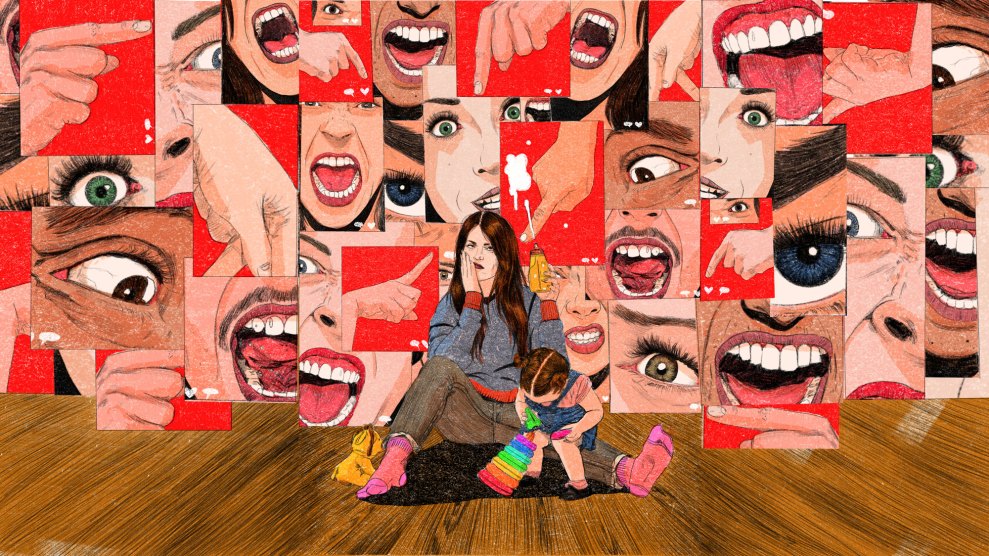
Mother Jones illustration; Unsplash; Getty
When Mother Jones is working on an important project, our first instinct is to tell you about it. That’s why I’m excited to share our work to better serve Black readers. I’m eager to share what we’ve learned so far, tell you what work lies ahead, and hear how this work resonates with you. It strikes a really personal note with me, and I’ll tell you more about that, too.
In the fall of 2022, for the first time ever, Mother Jones launched a series of focus groups so that we can better serve Black readers. Focus groups might sound surprisingly old-school in this digital era. But that was exactly the point: If you get a bunch of people together to talk about Mother Jones, what might they say? The pilot was part of a long-term project to evolve and transform as our nonprofit news organization approaches our 50-year anniversary in 2026. We want to make sure we can serve a deeply engaged, multiracial and multicultural audience and grow that audience. While our focus groups were with Black audiences, the projects to expand our audience encompass other communities, too. And we intend to expand the focus groups to other communities in the future. But more on that in a bit.
Expanding our audience is not only essential for us to accomplish our mission, it is essential to our survival. Our country is rapidly becoming more multiethnic, more multicultural, and less white. This trend is expected to continue and to grow. We need to be building stronger connections to readers who are typically underserved by the news media: Black, Indigenous, Asian American, Latino, and queer communities.
But there are trends in audience behavior that we could be missing if we’re not asking the right questions—and listening to the answers. That’s because digital platforms like Instagram, YouTube, Facebook, and TikTok make it difficult to track demographic information about our readers and viewers. What we do know is mainly derived from our own surveys and a few other sources, and we estimate that between 20 and 25 percent of our digital audience identifies as BIPOC.
What else we know: We need to increase that, by a lot.
Of course, the best way to serve any group is to make amazing journalism about and for them. And we’re doing that every day. Many of our stories proudly center communities of color, women, the LGBTQ community, and those who have always led the fight for equality (see examples here, here, here and here). Our newsroom has broken stories about the backroom planning that fueled the plot to overturn the 2020 election, which is being investigated by a slew of officials, including District Attorney Fani Willis in Fulton County, Georgia. Trump allies have repeatedly tried to shut down her investigation. We also have shown how the United States imports sugar from companies that exploit workers in the Dominican Republic, and the GOP’s national strategy to weaponize disinformation against trans people. We lead with facts (Mother Jones’ legendary fellowship continues to train the best investigative journalists in the business) and avoid reflexive both-sidesism. We have an industry-leading style guide because word choices matter—that’s why our reporters write about Japanese American incarceration instead of “internment.”
We’re also innovating wherever we can: We have a successful creator residency, an initiative where we hired Garrison Hayes to expand upon Mother Jones’ reporting with original video explainers and analysis. We are building a powerful audience on TikTok and platforms for younger readers and we’re republishing our work in BIPOC and queer outlets (we’ve republished 100 articles in these publications in the past 12 months). Meanwhile, we’re increasing the number of BIPOC writers and artists whose work you see on all our platforms. Here’s an example of a change we made to one platform, the magazine: Over the past seven years we’ve doubled the percentage of BIPOC writers for the magazine. Now one in five bylines you encounter there is a writer of color. We’ve revamped internal processes, created more transparency around how we hire freelance writers (and here’s how to pitch us!), and created more opportunities for staff writers to write for the magazine. Magazine stories are a very small percentage of the total content published by Mother Jones, but the ripple effect of these changes has had an incredible impact throughout the organization. For example, we have increased the number of BIPOC artists we hire for freelance photography and now they account for 50 percent of that work.
But how is all this landing? While we could comb the comments of Instagram posts and survey our readers—and we do both!—there’s nothing quite like sitting around with a group of readers, asking what they think. And we want to listen, listen, listen.
We’d love to hear from you. How can we better serve readers?
We decided to conduct focus groups for a few reasons.
We are deeply interested in getting insights beyond our internal biases and assumptions. People who work in news organizations, including journalists of color, consume news much differently than everyday readers. For example, many people who work at Mother Jones devour news on many platforms: the website, social media, videos, print, podcasts, and various apps. We know from audience data and our own experience talking to readers that most news consumers have a few favorite platforms, and don’t use them equally. We wanted to learn more about what Black readers’ news needs were and what problems they faced when they wanted to get that information. Also we wanted to get insights that were specifically relevant to Mother Jones. There are lots of big marketing studies about Black consumers, but in addition to looking at that research, we wanted insights that were unique to our organization.
Late last year, we worked with consultant Cierra Hinton, who is the publisher of Scalawag and who has conducted similar research for her own organization, to recruit current and prospective Mother Jones readers to join us for in-depth group Zoom sessions. Fifty-seven readers answered the initial survey; 16 ultimately participated in the focus group sessions. The readers’ ages ranged from 31 to 59. We know these readers don’t represent all Black readers, but these sessions led to some illuminating insights. Here are a few:
- Mother Jones readers love that we are a source of high-quality investigative news and that we are not behind a paywall.
- Mother Jones readers like that we have an edgier, plainspoken style of reporting that’s always based on the facts.
- When seeking news and information, Black audiences say they lack enough access to high-quality, rigorous journalism that’s free and that provides a perspective that reflects their lived experiences.
- These readers often choose news outlets based on family recommendations. They follow journalists on social media they trust and often these relationships span reporters’ careers, even as they move on to jobs at other news outlets.
- Younger readers like to read international outlets as a way to get another take on US news.
What’s next: We’ll be working to infuse insights from the panel into existing and future projects and initiatives. For example, we learned that longtime readers are not always aware of what content we offer on other platforms, such as videos on TikTok or Instagram, and we are looking at ways to build more cross-promotion into our daily work. Also we are looking at ways to more clearly communicate how Mother Jones’ journalism fits into Black readers’ lives. We are staying in touch with these readers and updating them on what we’re working on, new staff we’ve hired, and recent stories that may be of interest. We also plan to do more focus groups in the future to connect with other important and expanding audiences, including Latino readers.
Finally, this project strikes a personal chord for me. Early in my career when I worked in local newspapers, I always assumed I was writing for a white audience. Even though I was a Black, queer reporter who had expertise in those communities, I thought I had to translate those insights so white readers would understand and value what I had to say. If my editor asked, “Would our readers care about this issue?” an unstated assumption hung in the air: that the reader was white, suburban, and upper-middle class.
It’s my hope that everyone at Mother Jones will think about the needs of readers like these focus group participants, as well as the other underserved readers, when they sit down to write a story, commission an illustration, record an interview, reach out to supporters, meet with potential partners, or shoot a video. That’s how our reporting can become even more essential for communities at the vanguard of change.













